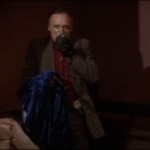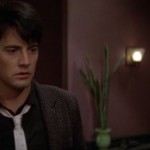Authors — Nicholas Rombes
-
The Blue Velvet Project, #147

Second #6909, 115:09 Detective Williams arrives, too late. Everyone dead is dead. Jeffrey is alive, but not because of the Law. Sandy, behind her father, behind the gun, swoons, electrified and ready to be taken by Jeffrey. This post is as good a post as any to suggest that, just beneath its surface, Blue Velvet is a “trash” film. It’s so overloaded with references to Hollywood’s traditions that always threatens to implode in on itself, perhaps nowhere else more poignantly than in this frame, which evokes everything from noir to the “woman’s picture” to the classic crime film. In Avant-Garde […]
by Nicholas Rombes on Aug 6, 2012 -
The Blue Velvet Project, #146

Second #6862, 114:22 In an unnervingly comic touch Frank approaches the closet where Jeffrey hides loaded up with his props, which include Dorothy’s blue velvet gown and his gas mask. He is the exterminator now, inhaling his chemicals, approaching Jeffrey and, ominously, the camera. For Frank has seen us, now. The invisible camera has been called out, hailed, interpolated. Frank stares back at us, returning our gaze, just as the bandit, gun in hand, did in Edwin S. Porter’s 1903 film The Great Train Robbery: Out of the shadows he comes, Dorothy’s tortured, neck and wrist bound husband at his […]
by Nicholas Rombes on Aug 3, 2012 -
The Blue Velvet Project: Confession
Confession With just 9 posts to go, I herein and forthwith offer my final confession. As author of The Blue Velvet Project—which owes a moral debt to the Dogme 95 movement, whose practice of constraint was an inspiration—I feel obligated to make this public statement of confession regarding the rigors of the project. This is done in the spirit of Thomas Vinterberg’s confession regarding his film The Celebration. In post #143, I confess to knowing well in advance that I would not write much at all about the frame in question. I had been saving the William James quote for […]
by Nicholas Rombes on Aug 1, 2012 -
The Blue Velvet Project, #145

Second #6862, 114:22 Jeffrey, taking the gun from the Yellow Man’s jacket pocket, as Frank is in the bedroom, shooting. In addition to Jeffrey and the Yellow Man, there is the camera, or at least its presence, invisible in accordance with classical cinema’s codes, which, even after the deconstructive storms of postmodernism, are themselves invisible, having been absorbed into the very technologies that make film possible. In Blue Velvet, for the most part, the camera does not call attention to itself; most of its movement is motivated, aligned with, and justified by corresponding movements in the film’s narrative. And yet […]
by Nicholas Rombes on Jul 30, 2012 -
The Blue Velvet Project, #144

Second #6768, 112:48 Fragments: 1. Frank’s back to the camera. 2. Dorothy’s apartment stretched out in horizontal like a widescreen nightmare. 3. The vintage fridge, solid. 4. The black circle mirror above the bathroom pedestal sink. (If Roberto Bolaño had done the set design for Blue Velvet, the mirror would have been inscrutably evil.) 5. The silencer, attached. 6. The sconce on the wall above the couch, looking at first glance, in its isolated away, like the screaming mouth on Jeffrey’s wall. 7. The sadness of Dorothy’s husband’s dead paunch. 8. Frank’s death in under two minutes, uncertain at this […]
by Nicholas Rombes on Jul 27, 2012 -
The Blue Velvet Project, #143

Second #6721, 112:01 In an essay from 1929, “The Filmic Fourth Dimension,” Sergei Eisenstein wrote about the impossibility of “the single-meaningness” of the film frame, which “can never be an inflexible letter of the alphabet, but must always remain a multiple-meaning ideogram.” And part of the frame’s meaning lies outside of the frame itself, in the implied off-screen space that surrounds it, accumulated in fragments from places the film has already taken us. In the frame above, Jeffrey is in Dorothy’s bedroom, laying his trap for Frank, whom he knows is listening as he reveals his false location to Detective […]
by Nicholas Rombes on Jul 25, 2012 -
The Blue Velvet Project, #142

Second #6674, 111:14 The seemingly insignificant, glimpsed, unremembered moments of a film revealed in the details of a random frame. In this case, Jeffrey’s watch, fleetingly illuminated as he retraces his steps back up to Dorothy’s apartment, in flight from the Well-Dressed Man. The importance of the watch may be the very fact of its unimportance—it has no significance in terms of the plot. And yet, it is a part of the film; it constitutes an element of Blue Velvet’s image-archive. The frames come from a compressed sequence made up of 17 shots that, in less than a minute of […]
by Nicholas Rombes on Jul 23, 2012 -
The Blue Velvet Project, #141

Second #6627, 110:27 In one of Blue Velvet’s most unsettling moments, Jeffrey, on his way out of Dorothy’s carnaged apartment, sees the Well-Dressed Man coming towards the building in the night. Like some figure from a dream, he approaches, his police radio crackling. At this point, neither Jeffrey nor the audience knows, at least with any certainty, that the Well-Dressed Man is in fact Frank. In his essay “The Uncanny” (1919) Freud wrote that it is only this factor of involuntary repetition which surrounds with an uncanny atmosphere what would otherwise be innocent enough, and forces upon us the idea […]
by Nicholas Rombes on Jul 20, 2012 -
The Blue Velvet Project, #140

“I’m gonna let them find you on their own,” Jeffrey quietly says to himself, invoking Frank, who will appear again in a few minutes. Turning away from the camera, his ear might actually hear the song on the soundtrack, Ketty Lester’s version of “Love Letters,” released as a single in 1961: [jwplayer mediaid=”48654″] The song was written in 1945 by Victor Young and Edward Heyman, and appeared in the film Love Letters, which starred Jennifer Jones and Joseph Cotten. Adapted by none other than Ayn Rand (“People should be able to build what they want to build, when they want […]
by Nicholas Rombes on Jul 18, 2012 -
The Blue Velvet Project, #139

Second #6533, 108:53 1. Jeffrey’s reaction to the violence that has happened in Dorothy’s apartment shifts gradually in the moments that follow this shot from numbed horror to sorrow, as if what he sees before him (Dorothy’s husband and the Yellow Man, tortured and dead or dying) is in some sense the awful answer to his curiosity. 2. From Charles Musser’s The Emergence of Cinema: The American Screen to 1907: Sex and violence figured prominently in American motion pictures from the outset. In fact, such subjects were consistent with the individualized, peephole nature of the viewing experience: they showed amusements […]
by Nicholas Rombes on Jul 16, 2012
